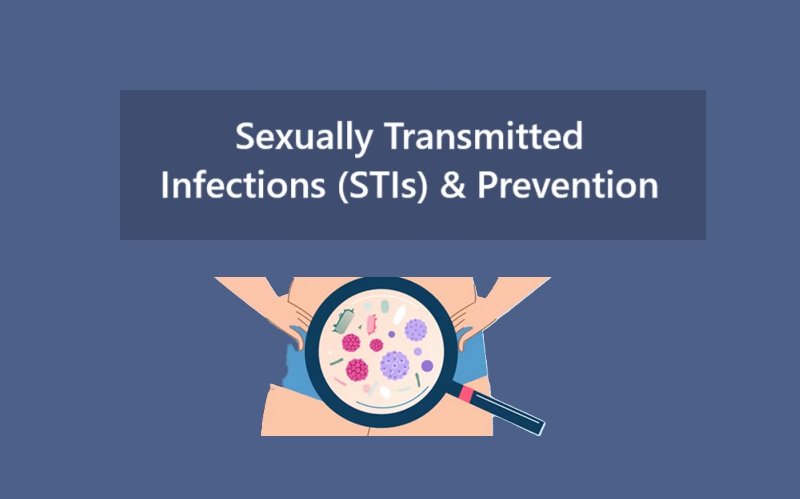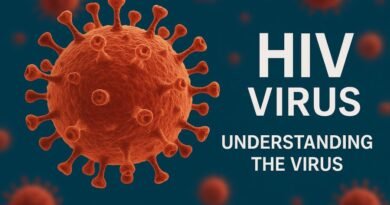
Sexually Transmitted Infections (STIs) & Prevention
Introduction
Sexually transmitted infections (STIs) are infections spread primarily through sexual contact. They can affect anyone who is sexually active, and understanding their causes, symptoms, treatments, and preventive measures is crucial for maintaining sexual health.
Common Types of STIs
STIs are caused by bacteria, viruses, or parasites. Below are some of the most common STIs and their key characteristics:
Bacterial STIs
- Chlamydia
- Symptoms: Pain during urination, abnormal discharge, genital pain (may be asymptomatic).
- Treatment: Antibiotics such as azithromycin or doxycycline.
- Gonorrhea
- Symptoms: Painful urination, genital discharge, and pelvic pain.
- Treatment: Antibiotics like ceftriaxone.
- Syphilis
- Symptoms: Sores, rash, fever, swollen glands (early stages); severe organ damage if untreated.
- Treatment: Penicillin injections are highly effective.
Viral STIs
- HIV/AIDS
- Symptoms: Flu-like symptoms initially; can progress to immune system failure.
- Treatment: Antiretroviral therapy (ART) to manage the infection.
- Human Papillomavirus (HPV)
- Symptoms: Genital warts, cervical cancer risk (some strains are asymptomatic).
- Treatment: Vaccines like Gardasil or Cervarix can prevent HPV strains linked to cancer.
- Herpes (HSV-1 & HSV-2)
- Symptoms: Painful blisters or sores around the mouth or genitals.
- Treatment: Antiviral medications like acyclovir reduce outbreaks.
- Hepatitis B (HBV)
- Symptoms: Fatigue, jaundice, abdominal pain.
- Treatment: Antiviral medications and vaccines for prevention.
Parasitic STIs
- Trichomoniasis
- Symptoms: Itching, burning, or unusual discharge.
- Treatment: Oral antibiotics like metronidazole.
- Pubic Lice (Crabs)
- Symptoms: Intense itching, visible lice or eggs in pubic hair.
- Treatment: Over-the-counter lotions and shampoos.
- Scabies
- Symptoms: Itchy rashes and burrow marks on the skin.
- Treatment: Prescription creams and thorough hygiene practices.
Symptoms of STIs
While some STIs are asymptomatic, common signs may include:
- Unusual genital discharge
- Burning sensation during urination
- Sores, blisters, or ulcers around the genital area
- Itching, irritation, or swelling
- Unexplained rashes or skin changes
- Pain during intercourse
Diagnosing STIs
Early diagnosis is crucial for effective treatment and prevention of complications.
Methods of Diagnosis
- Blood Tests: Detect HIV, syphilis, and hepatitis.
- Urine Tests: Common for detecting bacterial infections like chlamydia and gonorrhea.
- Swab Tests: Samples from the genital area, throat, or rectum to identify pathogens.
- Physical Examination: Visual inspection for warts, sores, or rashes.
Preventive Measures
Preventing STIs requires a combination of safe practices, vaccination, and regular testing.
Key Prevention Strategies
- Condom Use:
- Consistently using condoms during vaginal, anal, or oral sex is highly effective in reducing STI transmission.
- Vaccination:
- HPV Vaccine: Protects against HPV strains linked to cancer.
- Hepatitis B Vaccine: Provides long-term immunity.
- Regular Testing:
- Routine screening helps detect asymptomatic STIs early.
- Limiting Sexual Partners:
- Reducing the number of partners lowers the risk of exposure.
- Pre-Exposure Prophylaxis (PrEP):
- A daily medication that reduces the risk of contracting HIV.
- Post-Exposure Prophylaxis (PEP):
- Emergency treatment for individuals potentially exposed to HIV.
- Avoid Sharing Personal Items:
- Items like razors, towels, and sex toys should not be shared without proper cleaning.
- Open Communication:
- Honest discussions with partners about sexual history and STI status foster trust and ensure informed decisions.
Managing STIs After Diagnosis
- Follow Medical Advice: Complete all prescribed treatments even if symptoms improve early.
- Inform Sexual Partners: Partners should be informed to undergo testing and receive treatment if necessary.
- Abstain During Treatment: Avoid sexual activity until the infection clears to prevent reinfection.
Myths About STIs
- “Only promiscuous people get STIs.”
- STIs can affect anyone who is sexually active, regardless of lifestyle.
- “You can tell if someone has an STI by their appearance.”
- Many STIs have no visible symptoms.
- “Oral sex is completely safe.”
- STIs like herpes, gonorrhea, and HPV can spread through oral sex.
- “Condoms are 100% effective.”
- While highly effective, condoms are not foolproof; regular testing remains important.
Conclusion
Understanding STIs, their symptoms, treatments, and preventive measures is vital for protecting your sexual health. Practicing safe sex, getting vaccinated, and maintaining open communication with partners are essential steps in reducing STI risks and ensuring overall well-being.
Disclaimer: This article is for educational purposes only and is not a substitute for professional medical advice. Always consult a healthcare provider for personalized guidance on sexual health.
Read This: Maintaining Hygiene in Intimacy: Essential Practices for Sexual Health
Read This: Understanding Lubricants: Types and Uses for Intimacy






